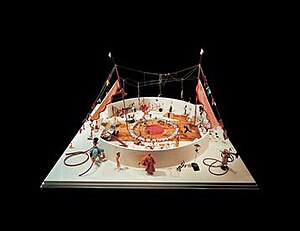Cirque Calder
| Cirque Calder | |
|---|---|
 | |
| Artist | Alexander Calder |
| Year | 1926–31 |
| Type | sculpture |
| Dimensions | 137.2 cm × 239.4 cm × 239.4 cm (54.0 in × 94.3 in × 94.3 in) |
| Location | Whitney Museum, New York, N.Y. |
| Owner | Whitney Museum |
Cirque Calder is an artistic rendering of a circus created by the American artist Alexander Calder. It involves wire models rigged to perform the various functions of the circus performers they represent, from contortionists to sword eaters to lion tamers. The models are made of various items, generally wire and wood. Calder began improvising performances of this circus during his time in Paris. He would comment in French during the performance.
The Cirque Calder is part of the permanent collection of the Whitney Museum in New York.[1]
Bibliography
Calder, Alexander. An Autobiography With Pictures. HarperCollins, ISBN 0-06-853268-7.
References
- ^ "Archived copy". Archived from the original on 2016-12-07. Retrieved 2013-02-28.
{{cite web}}: CS1 maint: archived copy as title (link)
